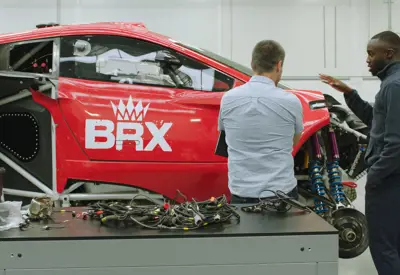
Aerodynamics engineer
Aerodynamics engineers design objects from wind turbines to aircraft and study the flow of gases around objects.
What is aerodynamics?
Aerodynamics is the study of gas flows, such as air, around an object, and the moments and forces that are generated.
It’s important to understand aerodynamics to make aircraft more environmentally-friendly, create a really fast racing car or design a wind turbine which generates a lot of electricity.
What is an aerodynamicist or aerodynamics engineer?
Aerodynamics engineers, or aerodynamicists, study the impact of gases and the forces they creates.
They design the shapes of vehicles, buildings or products that interact with the gas, usually to increase lift or downforce, reduce drag and improve cooling, and make sure these effects continue during operation.
What do aerodynamicists do?
Aerodynamicists work in a lot of engineering fields.
You could be designing defence equipment such as spacecraft, satellites and missiles.
You could use aerodynamics to reduce aircraft emissions and noise pollution, or design Formula 1 cars to reduce lap times and improve driver safety.
You could be designing super efficient wind turbines for different terrains and weather to generate clean energy.
Factfile
- Average starting salary (graduate)
- £30,000
- Senior engineer
- £50,000-70,000+
- Chief engineer
- £200,000+
- Example job titles
- Aerodynamicist, CFD engineer, aerothermal engineer
- Desirable skills
- Problem solving, attention to detail, mechanical reasoning
- Useful subjects
- Maths, physics, design and technology
What other types of engineers work alongside aerodynamicists?
Aerodynamicists usually work as part of a big team formed of mechanical engineers, performance engineers, design engineers, and others.
Where does an aerodynamicist work?
Aerodynamicists work in research or manufacturing settings. They tend to work normal office hours. Some weekend or evening work might be necessary depending on the industry. For instance, Formula 1 aerodynamicists may work some weekends to implement last-minute design changes before races, or to test their designs in specially designed 'wind tunnels'.
Working life
What does a day at work look like for an aerodynamics engineer?
You could be:
- Analysing and planning tests for your design in the 'wind tunnel' or on computational simulations (known as CFD)
- Writing or designing software to extract useful information from the large amount of aerodynamic data that is measured from these tests
- Creating new shapes using computer-aided-design (CAD) to meet the current set of aerodynamic design objectives
- Presenting research, designs and solutions to suppliers, clients and senior engineers, or working with designers, drivers/pilots, users to fine-tune the product
- Researching the right material for a car to make sure it’s suitable and sustainable
- Collaborating with customer service, legal air safety and marketing departments
The future
Aerodynamics is only going to get more important. With increased consciousness of noise and emissions of cars, aircraft and buildings, aerodynamics is going to play a key role in meeting sustainability goals.
Simulation and flow visualisation techniques are also advancing rapidly and becoming more complex. Future aerodynamicists will need understand what information is most important to achieving the design goals.
Where could this job take me?
- You could progress to more senior roles, such as the leader of an aerodynamics team
- You could move into another area of aerodynamicist, from Formula 1 to aircraft
- You could work in academia as a lecturer or researcher, or become a freelance aerodynamics consultant
- You’ll have strong data analysis and project management skills so you could move into completely a different field

Become an aerodynamicist
How do I become an aerodynamicist?
Get started
- GCSEs or equivalent: Maths, physics, chemistry, design and technology
- A levels or equivalent: Maths, physics (further maths, chemistry, design and technology can also be useful).
Then...
- Apprenticeship: There are apprenticeship opportunities at aircraft manufacturers, Formula 1 racing teams and more.
- Undergraduate degree: Aeronautical engineering, mechanical engineering, aerospace engineering or a related field.
Later...
You might like to continue studying, taking a postgraduate degree in aerodynamics or aerospace engineering if you’d like to pursue research in the field.
How do I find work experience?
Find a placement with…
- experience analysing data; a good aerodynamicist has a lot of experience analysing and interpreting data of all types
- experience of coding ang programming; aerodynamicists are familiar with multiple coding languages, know how to programme and understand how to 3D model.
Look for opportunities at university or elsewhere to get involved in extra-curricular projects or challenges (such as Formula Student), which may allow you to gain experience in the practical application of theory, perhaps to a situation you’d not previously considered.
Tips and advice
Become a member of the Royal Aeronautical Society - Careers in Aerospace
Think engineering could be for you?
Become an engineer
